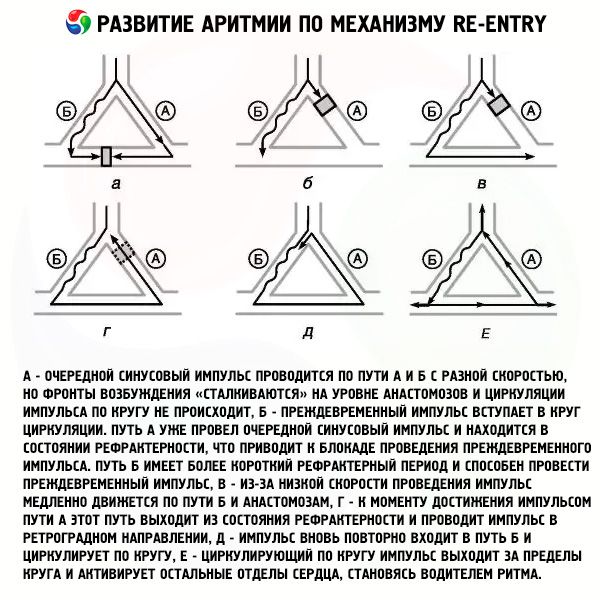Medical expert of the article
New publications
Pathogenesis of supraventricular tachyarrhythmias
Last reviewed: 04.07.2025

All iLive content is medically reviewed or fact checked to ensure as much factual accuracy as possible.
We have strict sourcing guidelines and only link to reputable media sites, academic research institutions and, whenever possible, medically peer reviewed studies. Note that the numbers in parentheses ([1], [2], etc.) are clickable links to these studies.
If you feel that any of our content is inaccurate, out-of-date, or otherwise questionable, please select it and press Ctrl + Enter.
Intracardiac mechanisms of development of supraventricular tachyarrhythmias include anatomical and electrophysiological conditions of occurrence of abnormal electrophysiological mechanisms of cardiac excitation: presence of additional impulse conduction pathways, foci of abnormal automatism, trigger zones. The basis of sinus tachycardia is increased automatism of the sinus node pacemakers themselves.
The occurrence of abnormal electrophysiological processes in the myocardium may be due to anatomical reasons (congenital cardiac anomalies, postoperative scars). For the formation of the electrophysiological substrate of heterotopic arrhythmia in childhood, the preservation of the embryonic rudiments of the conduction system is important; the role of mediators of the autonomic nervous system has been experimentally demonstrated. The most common direct electrophysiological mechanisms for the occurrence of supraventricular tachyarrhythmias are re-entry and abnormal automatism. The re-entry mechanism is due to the circulation of the myocardial excitation impulse. Along one branch of the re-entry loop, excitation spreads antegradely, along the other - in the opposite direction, retrogradely. Depending on the size of the impulse circulation loop, macro- and micro-re-entry are distinguished. With macro-re-entry, circulation is carried out along anatomical pathways, for example, the Ket bundle in Wolff-Parkinson-White syndrome. In macro-re-entry, the impulse circulation occurs along functional pathways. Abnormal automatism occurs in the tissues of the atria or the AV node, sometimes in the vessels directly in contact with the atria (vena cava, pulmonary veins). The sinus node is suppressed, and the ectopic focus becomes the dominant pacemaker.
The occurrence and maintenance of the vegetative basis of arrhythmia (extracardiac mechanisms) is caused in childhood by the disturbance and peculiarities of maturation and functioning of the vegetative centers of rhythm regulation. In chronic sinus tachycardia, there is an increase in sympathetic influences on the heart. In non-paroxysmal supraventricular tachycardia in children without organic heart disease, on the contrary, there is a deficiency of activating sympathetic influences on the heart (hyperfunction of the parasympathetic and hypofunction of the sympathetic part of the autonomic nervous system). Paroxysmal supraventricular tachycardia develops against the background of a decrease in the functional reserves of adaptation of the sympathetic-adrenal link of heart rhythm regulation. It is considered as a variant of hyperadaptation to stress and other types of extra- and intracardiac stimulation in children with special electrophysiological properties of the myocardium and the cardiac conduction system.
 Extracardiac and intracardiac mechanisms interact. In each clinical case, their contribution to the occurrence and maintenance of arrhythmia is individual. In young children, especially in the first year of life, intracardiac mechanisms of supraventricular tachyarrhythmias prevail. This is due to the anatomical and physiological features of the maturation of the cardiac conduction system. With age, up until the end of puberty, the role of neurohumoral mechanisms increases. The impact of risk factors is mediated by their effect on humoral regulation of cardiac activity, water-electrolyte and acid-base balance, and myocardial metabolism. Inflammatory and degenerative processes in the myocardium can become the basis for the occurrence of supraventricular tachycardia.
Extracardiac and intracardiac mechanisms interact. In each clinical case, their contribution to the occurrence and maintenance of arrhythmia is individual. In young children, especially in the first year of life, intracardiac mechanisms of supraventricular tachyarrhythmias prevail. This is due to the anatomical and physiological features of the maturation of the cardiac conduction system. With age, up until the end of puberty, the role of neurohumoral mechanisms increases. The impact of risk factors is mediated by their effect on humoral regulation of cardiac activity, water-electrolyte and acid-base balance, and myocardial metabolism. Inflammatory and degenerative processes in the myocardium can become the basis for the occurrence of supraventricular tachycardia.

